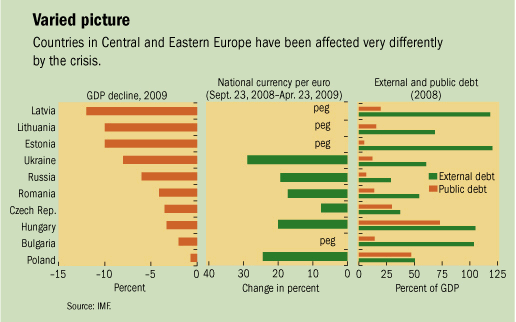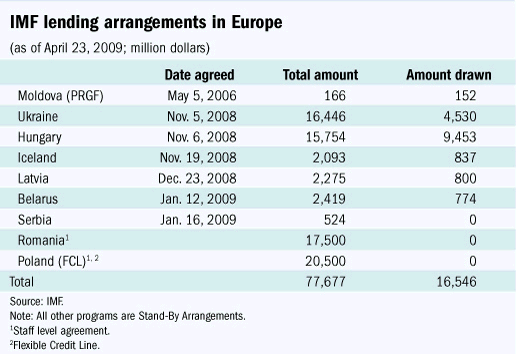
Typical street scene in Santa Ana, El Salvador. (Photo: iStock)
IMF Survey: Financial Sector Key to European Recovery: IMF
April 24, 2009
- Europe still in deep recession but could turn corner in mid-2010
- Financial sector holds key to recovery in advanced Europe
- More forceful action needed to restore confidence
Marek Belka, head of the IMF’s European Department, said he is cautiously optimistic that Europe’s economy, mired in a deep recession, will turn the corner in mid 2010.

Computer plant in Augsburg, Germany: Europe’s exporters hard hit by sharp drop of global spending on capital goods, durables (photo: Newscom)
OUTLOOK FOR EUROPE
“We are all hopeful that this is the beginning of a changing situation. But we are very careful and cautious about describing it as a turning point,” he told reporters on April 24 ahead of the IMF-World Bank Spring Meetings.
Belka cautioned that some countries may see a further delay of an expected return to positive growth. “Even countries that started out with sound domestic policies and have so far been more resilient could be at risk from a possible fallout of a deepening global recession.”
Belka said that the financial sector holds the key to Europe’s recovery and that governments must act more forcefully to clean up the banks. “Let me reiterate, with all force, that it depends on how efficiently we deal with the financial sector. Nothing will work properly and fast enough without it.”
Europe hit by twin shocks
In prepared remarks, Belka explained that the downturn in Europe was triggered by the global financial crisis and the sharp drop in trade. The twin nature of the shock is particularly painful for Europe because of its deep integration in the world economy. Following the rapid expansion of trade in recent years, exporters have been hard hit by the sharp drop of global spending on capital goods and durables.
But advanced Europe also has its share of home-grown problems, Belka said. In some economies, such as Spain and Ireland, real estate busts are worsening the recession, as households and firms cut back demand and banks react to the rapid deterioration of their credit and asset portfolios by curbing lending. Similarly, some European banks were as guilty of high leveraging and use of adventurous funding models as U.S. financial institutions.
Toxic assets must be dealt with
The financial sector is at the heart of Europe’s problems but also holds the keys to recovery, Belka said. While progress has been made, Europe still needs to act more forcefully to restore financial confidence. This requires recognizing losses in a forward-looking way, further recapitalization, and addressing difficult-to-value impaired assets. “This to-do list is not specific to Europe—what is specifically European, however, is that getting the financial sector in order will require effective cooperation between the various governments and authorities.”

Asked about what specific actions governments should take, Ajai Chopra, Deputy Director in the European Department, said more proactive efforts are needed to recognize losses and recapitalize banks. But Europe also needed to establish an effective crisis resolution framework that enables it to deal with distress in banking systems.
Varied picture across emerging Europe
In central and eastern Europe, the severity of the downturn varied considerably from country to country (see chart), reflecting the state of the economy before the downturn as well as the choice of policy frameworks, Belka said. By and large, central and eastern Europe has been affected through two channels:
• Exports have plummeted, given the region’s high degree of integration into global trade and its heavy reliance on manufactured goods, including consumer durables like autos and electronics. In some countries, industrial production since the beginning of the year has fallen by more than 30 percent. For floating exchange rate countries, the low level of global demand has severely limited the supply response to the currency depreciations in the region.
• Capital flows have been severely curtailed. Much of eastern Europe’s recent rapid growth has been financed by capital inflows to the private sector. The economic downturn and, in some countries, depreciating currencies are bound to lead to increases in non-performing loans and could endanger the soundness of financial sectors.
IMF’s role
The IMF is already deeply involved in lending to those countries most hit by the crisis (see table). IMF-supported programs are helping countries such as Hungary, Latvia, Romania, and Ukraine fill financing gaps, ease the burden of fiscal adjustment, and repair banking systems. “Our programs have been tailored to individual country circumstances and focus on the most immediate issues to resolve the crisis,” Belka said.
Other countries, such as Poland, were also affected by the crisis, but more as innocent bystanders, and were mainly in need of insurance against the crisis, he said. In mid-April, Poland became the second country to seek access to a new Flexible Credit Line (FCL) the IMF is offering to strongly performing economies.
In response to a question about whether Hungary might be able to transition from its current Stand-By Arrangement (SBA) to the FCL, Belka said there is no clear or automatic link between the SBA and FCL. “The program in Hungary is basically on track, and we are prepared to negotiate how this program will be continued, should the government want to pursue that option,” he said.

In response to a question about the Baltic countries, Belka explained that Estonia, Latvia, and Lithuania have made a clear political choice to maintain their currency pegs. “It was a choice made in the early 1990s, and it was the main pillar of stability for their economies,” he said. And while it was fair to ask what exchange rate regime is most helpful in terms of helping unwind imbalances that have built up during the many years of strong growth, there was no good solution. “Whatever you do, you have to go through a painful adjustment process. What is very important is to have an exit strategy,” Belka said.
For the Baltics, accession to Europe’s monetary union provided a clear exit strategy. “If they stick to this and do what is necessary, even if it is very painful, we hope that they would arrive at a moment when the European institutions will limit what is acceptable for them to join the European Monetary Union. This is the positive scenario that they should stick to, and what we are basing our current program in Latvia on.”
Stabilizing the banking sector
Stabilizing financial sectors in central and eastern Europe will require joint action by home and host countries of banking groups active in the region, Belka said. “There is a collective action problem, because parent banks are often based in different west European countries. These banks have made significant investments but will only stay engaged if they are assured that other banks will not benefit by leaving early.”
Belka explained that the IMF was working closely with other international financial institutions to establish agreed principles of home and host country responsibilities for recapitalization. In countries that have IMF-supported programs in place, the IMF has sought formal agreements on roll-over rates for credit and shared responsibility for maintaining adequate capital levels.
IMF Senior Advisor Anne-Marie Gulde said in response to a question on Austria’s banking exposure that it amounted to about 70 percent of its GDP. “Clearly the developments in eastern European countries will affect the profitability and the capitalization of Austrian banks. But so far we have seen a decisive response from the Austrian authorities. Austrian banks have been recapitalized at home with an ability to recapitalize the subsidiaries in those countries, and this has helped stabilize and minimize the effects that we see in the eastern European countries.”
Comments on this article should be sent to imfsurvey@imf.org







